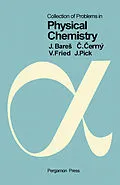Collection of Problems in Physical Chemistry provides illustrations and problems covering the field of physical chemistry. The material has been arranged into illustrations that are solved and supplemented by problems, thus enabling readers to determine the extent to which they have mastered each subject. Most of the illustrations and problems were taken from original papers, to which reference is made.
The English edition of this book has been translated from the manuscript of the 2nd Czech edition. It has been changed slightly in some places and enlarged on in others on the basis of further experience gained in teaching physical chemistry at the Institute of Chemical Technology in Prague.
The book begins with illustrations and problems on the atomic structure and the fundamentals of quantum mechanics. Subsequent chapters cover the kinetic theory of ideal gas; fundamentals of thermodynamics; states of matter; phase equilibrium; chemical equilibrium and third law of thermodynamics; electrochemistry; reaction kinetics; surface phenomena and colloidal systems; and molecular structure and physical properties.
Inhalt
Foreword to the Czech Edition
Foreword to the English Edition
I. Atomic Structure and the Fundamentals of Quantum Mechanics
A. Atomic Structure
1. Determination of Specific Charge of Electron from Deflection in Magnetic Field
2. Determination of Electronic Charge
3. Determination of Neutron Mass from Nuclear Photoeffect in Heavy Hydrogen
4. Determination of Wave-Length of Electron from Diffraction on Grating
5. Determination of Positron Mass
6. Photoelectric Effect-Calculation of Characteristic Frequency and Planck Constant
7. Compton Effect-Shift in Wave-Length of Xrays
8. Spectral Distribution of Black-Body Radiation
9. Determination of Atomic Number by Means of X-Ray Spectra
10. Calculation of Wave-Length of Lines of Balmer Series of Hydrogen
11. Determination of Isotopes by Means of Electronic Spectra
12. Calculation of Electronic Mass from Eydberg Constants Oi Hydrogen and Helium
13. Calculation of Critical Potentials of Helium from Spectroscopic Data
14. Eate of Radioactive Disintegration and Radioactive Equilibrium
15. Estimation of Radioactive Constant by Geiger-Nuttall Rule
B. The Fundamentals of Quantum Mechanics
1. Calculation of Translational Partition Function of Ideal Gas
2. Eotational Partition Function of Carbon Monoxide
3. Vibrational Partition Function of Hydrogen Chloride
Problems
Results
II. Kinetic Theory of Ideal Gas
1. Calculation of Molecular Velocities
2. Calculation of Molar Heat Capacity
3. Mean Free Path
4. Collision Diameter of Molecules
5. Collusion Diameter and Diffusion Coefficient
6. Determination of Molecular Weight from Effusion of Gas
7. Determination of Vapour Pressure by Effusion Method
Problems
Results
II. Ideal Gas
1. Boyle's Law
2. Gay-Lussac's Law and the Absolute Temperature Scale
3. Ideal Gas Equation-Calculation of Volume
4. Ideal Gas Equation-Calculation of Molecular Weight
5. Determination of Molecular Weight by Method of Limiting Densities
6. Ideal Gas Equation-Degree of Dissociation
7. Calculation of Degree of association from Molecular Weights
8. Expression of Concentration of Gas Mixtures
9. Calculation of Total Pressure of Gas Mixture from Dalton's Law
10. Calculation of Partial Pressure from Dalton's Law
Problems
Results
IV. Fundamentals of thermodynamics
A. First Law of thermodynamics
1. Calculation of Units
2. Calculation of Change in Internal Energy during Evaporation
3. Calculation of Specific and Atomic Heat Capacities from Calorimetric Data
4. Dependence of Molar Heat Capacity on Temperature
5. Calculation of Heat of Reaction from Heats of Formation
6. Calculation of Standard Heat of Formation from Known Heats of Reaction
7. Calculation of Heat of Reaction from Heats of Combustion
8. Calculation of Standard Heats of Formation from Bond Energies
9. Dependence of Standard Heat of Reaction on Temperature
10. Enthalpie Balance
11. Theoretical Flame Temperature
12. Work during Isothermal Process
13. Heat, Work and Change in Internal Energy during Expansion of Ideal Gas
14. Adiabatic Process
15. Work Done during Adiabatic Process
16. Thermal Engine
17. Cooling Engine
Problems
Results
B. Second Law of thermodynamics
1. Dependence of Entropy on Pressure
2. Dependence of Entropy on Temperature
3. Graphical Calculation of Entropy Change with Temperature
4. Entropy of Mixing
5. Entropy Change during Irreversible Adiabatic Process
6. Isothermal Change in Free Energy and Free Enthalpy of Ideal Gas
7. Dependence of Free Enthalpy on Pressure
8. Change in Free Enthalpy during Isomorphous Transformations
9. Change in Free Enthalpy in Irreversible Phase Transformations
10. Thermodynamic Functions of Ideal Gas
Problems
Results
V. States of Matter
A. Keal Gases
1. Calculation of Volume from Berhelot Equation
2. Calculation of Volume from Beattie-Bridgeman Equation
3. Calculation of Density from Generalized Compressibility Diagram
4. Comparison of Van Der Waals Equation with Generalized Compressibility Factor
5. Calculation of Temperature from Generalized Compressibility Diagram
6. Determination of Second Virial Coefficient by Method of Limiting Densities
7. Beattie-Bridgeman Equation for Mixture of Gases
8. Calculation of Pressure of Gas Mixture Using Generalized Compressibility Diagram
9. Joule-Thomson Coefficient
10. Dependence of Molar Heat Capacity on Pressure
11. Difference in Molar Heat Capacities EP-EV for Real Gas
12. Calculation of Fugacity by Analytical Method
13. Calculation of Fugacity of Constituent in Mixture
Problems
Results
B. Liquids
1. Calculation of Density Using Generalized Expansion Factor
2. Calculation of Surface Tension from Capillary Rise
3. Eötvös Equation
4. Calculation of Viscosity from Poiseuille Equation
5. Stokes' Law
Problems
Results
C. Solids
1. Determination of Constants of Ionic Lattice from Diffraction of X-Rays
2. Estimation of Molar Heat Capacity of Solid Means of Kopp's Law
3. Determination of Temperature Dependence of Molar Heat Capacities of Solids from Known Characteristic Temperature
4. Calculation of Molar Heat Capacities of Solids on Basis of Born-Kârmân Theory
5. Calculation of Characteristic Temperature from Compressibility
6. Calculation of Characteristic Temperature from Melting Point
Problems
Results
VI. Phase Equilibrium
A. Systems with One Co…
